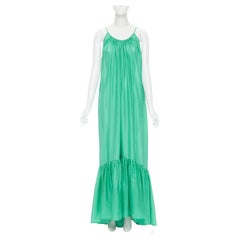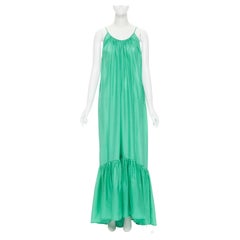Kalita Brigitte
Recent Sales
2010s Indonesian Maxi Dresses
2010s Indonesian Maxi Dresses
2010s Indonesian Maxi Dresses
Finding the Right Day-dresses for You
Luxurious and versatile, designer day dresses are as well suited to tea at an upscale hotel as they are to your next garden or rooftop party.
Today’s featherlight unisex day dresses — as well as the vibrant vintage day dresses of the 1950s and ’60s — look quite different from the heavy, fabric-rich de rigueur garments of the Victorian era. In the late 19th century, a woman of a certain standing might have multiple dresses to wear throughout the day: specifically, one or two for the daytime and one for the evening. For example, a long-sleeve silk dress with a prominently flared back and a round collar of gold beaded lace that hugs the neck would be suitable for stepping out during the day, while a velvet gown trimmed in silk embroidery but overall comparatively informal in appearance would be worn for afternoon tea at home. At night, a silk velvet evening dress could feature natural world motifs such as butterflies (a characteristic of Art Nouveau design) and have short sleeves adorned with lace and ruffles and a scooped neckline — the perfect attire for the theater.
During the 1920s, after all the chores were done, a woman would change from her housework clothing into a more fashionable day dress to run her errands or socialize. Some 1920s day dresses were brightly colored and featured bold patterns — a cotton dress with a dazzling floral print, perhaps, or, in the case of the more venturesome Art Deco apparel sold in high-end couture fashion boutiques of the era, semi-sheer silk garments embellished with three-dimensional beadwork or rich metallic gold lamé.
Today, a closet full of casual vintage day dresses is a must-have. Whether you opt for black, crimson or beige, day dresses bring an element of glamour to your next appointment, and in the summer, who doesn’t love a wonderfully simple, lightweight day dress cut in cotton and linen?
Because different fashion designers of every decade have offered their own take on the widely loved day dress, you’ll be able to find a variety of vintage and designer day dresses on 1stDibs. Search by creator to find enduring designs by the likes of Emilio Pucci, Pierre Cardin, Yves Saint Laurent and Christian Dior, or browse by period to uncover a scintillating collection of cotton and satin patterned dresses of the 1950s and ’60s.
Read More
Barbra Streisand Channeled Klimt’s ‘Woman in Gold’ in This Shimmering Dress
Costumer to the stars Ray Aghayan brought the famed painting to life with his spectacular design.
A Chanel Obsessive’s Cache Extends Well beyond Her Walk-In Closet
From handbags and heels to jackets and jewels, Sharon Coplan Hurowitz has a deep admiration for (and collection of) all things Chanel.
Behind the 1970s and ’80s Glam of ‘Halston’ with the Hit Show’s Costume Designer
Jeriana San Juan explains how she undertook the intimidating project of designing costumes for the new Netflix series about the New York fashion legend. (Hint: She found vintage Halston on 1stDibs!)
A Short History of Capri Pants, on the 100th Birthday of Their Inventor
Once considered a controversial item of clothing, fashion designer Sonja de Lennart's creation is now a bona fide classic.
How the Chanel Jacket Forever Changed What Women Wear
The classic tweed garment has been a wardrobe staple of chic women around the world since the 1950s.
A Pair of Shoes — Heels or Flats — Can Tell an Impactful Story
Amanda Benchley and Bridget Moynahan teamed up to explore the relationship between powerful women and their most significant footwear.
You Saw It at the Met Ball. Here’s What Camp Fashion Is Really About
This year's Costume Institute exhibition is all about embracing the eccentric.
The V&A Takes a Fresh Look at the New Look’s Pioneering Progenitor, Christian Dior
Ballrooms, Bar Suits and British royals — in a sweeping exhibition, the London museum looks back on 70 years of the French fashion house, as well as its illustrious founder and his fondness for the United Kingdom.

